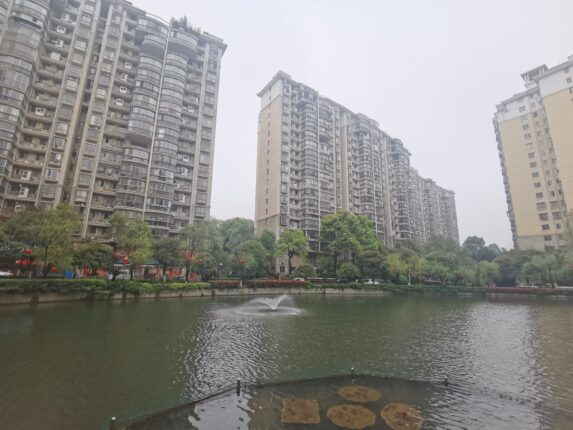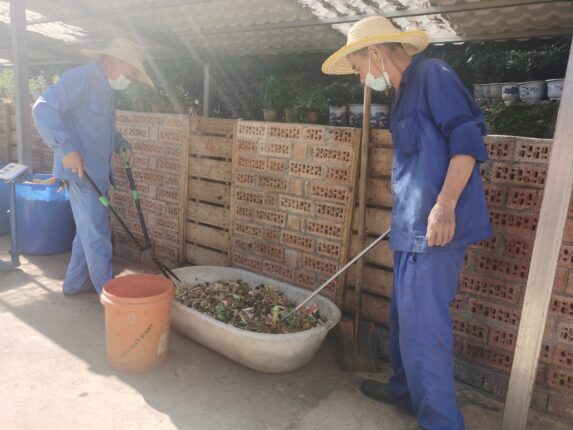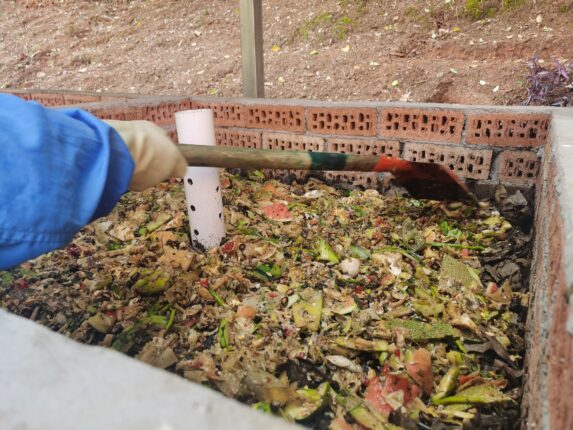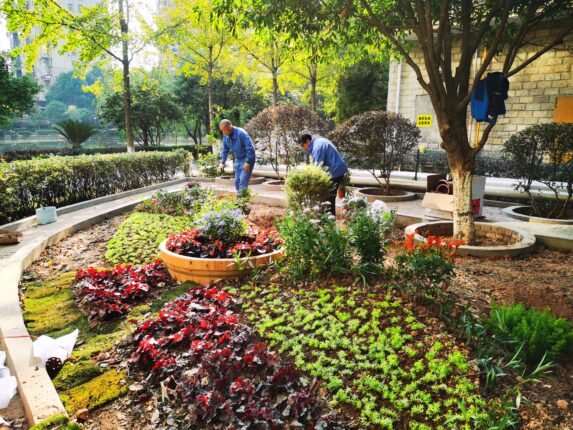-
Bottom-Up Food Waste and Climate Solution in China
December 21, 2023 By Xuehua Zhang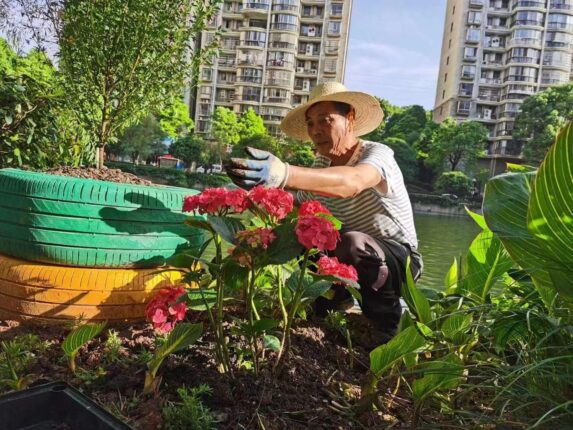
China is the world’s largest emitter of methane, a short-lived climate pollutant that traps 80 times more heat than carbon. Coal mining, agriculture, and food waste are China’s three biggest methane emitters. Among them, food waste holds the most promise for near-term climate action.
Food waste accounts for approximately 50% of municipal solid waste produced in China, with most ending up in landfills or incinerators, the major sources of the country’s waste methane emissions. China’s landfills are notably filling up and incinerators are costly. Since launching its War on Waste in 2018, Beijing has pushed cities to better sort and collect food waste and to invest in industrial-scale food composting to capture methane. Spurring better separation of food waste in China’s megacities is tough and requires considerable education of consumers and businesses. Community composting could help fill this gap.
I have had a front row seat to the potential power of community composting. In late 2018, my organization, the Lishui Institute of Ecology and Environment, joined the Vanke Foundation to launch China’s first countrywide community composting program. As of 2023, we have nearly 50 participating communities, mostly urban residential complexes, in 22 cities across 14 provinces. This five-year pilot program has demonstrated how community composting can close the loop on food waste locally and mitigate methane emissions. Bottom-up composting could help China build carbon-neutral communities.
Composting Packs a Low-Carbon Punch
Composting is a natural way of recycling nutrients from organic waste back into the soil to grow food for humans. Organic waste can include biodegradable yard waste, food waste, manure, and agricultural residuals. Composting not only avoids pollution and greenhouse gas emissions associated with landfills and incineration, but also enhances soil’s capacity for carbon sequestration. When composting takes place close to where the food waste was generated, it also minimizes carbon emissions from long-distance waste transportation. Community composting closes the loop on food waste, fosters eco-friendly behavioral changes among residents, and opens up local green jobs. With best management practices, this approach generates very little, if any, human-induced methane emissions.
Globally, community composting is on the rise. The city of Bengaluru, India issued a citywide mandate in 2013 requiring source separation of waste and onsite composting of food waste within residential complexes. The government of Pontevedra in Spain installed a regional community composting program in 2015. Recently, the California state government funded a statewide community composting program as a part of its efforts to divert organic waste from landfills and cut methane emissions.
In 2017, after completing an in-depth study in Bengaluru, I started researching, experimenting, and promoting community composting in China. The participating communities are encouraged to collect and process at least 100 kg of separated food waste each day, usually mixing it with yard waste, dry leaves, and sawdust. We have trained many residential communities in the process and established quality control standards for compost; some now recycle all of the food waste within the community.
Turning Waste into Fertilizer in Changsha
Bihuali is a typical large mid-rise urban residential complex in Changsha, the capital of Hunan Province, with nearly 2,000 households. This complex has a uniquely strong self-governing system operated by an Owners Committee. Although it has lots of public green spaces with trees and gardens, the local soil is poor and flowers don’t grow well. The property manager who grew up in the countryside knew composting could enhance the fertility of soil, but he was unsure if composting could work in an urban setting. In October 2020, following the government requirements, residents in this community started sorting their waste into dry recyclables, food waste, and non-recyclables. Although its sorting efforts were not 100% successful, it provided a basis for the community to join our program in 2021. They needed our technical and management support to overcome obstacles often faced in composting.

Bihuali urban residential complex in Changsha They chose to install 12 bin composters made of brick in their residential courtyard. The Owners Committee designated a half-time employee to manage daily composting operations with an assistant. Two cleaning staff assist them by collecting and delivering food waste to the composting site. Each day, the team mixes food waste with crushed yard waste and monitors the composting piles (e.g., taking temperature, checking moisture level, odor, flies, and leachate).

Staff delivering food waste to the composting bins in Bihuali 
Mixed food waste and yard waste in a compost bin During the first year (June 2021-May 2022), the Changsha complex processed nearly 20 tons of food waste and 7 tons of yard waste. Excluding days when composting was halted for COVID control, an average of 106 kg of organic waste was processed daily. The quality of the finished compost met our testing standards and was spread throughout the gardens. Residents applauded the changes brought by composting. Some residents told us, “we finally could grow many types of flowers in our yard. The flowers look healthy and beautiful. Everyone loves compost!” The Owners Committee and the property manager have become confident in onsite composting and are making plans to scale up the operation.

Compost has helped flowers thrive in Bihuali’s garden Government Support to Help Composting Bloom
Our project has shown community composting can work in China’s megacities, but these grassroots efforts desperately need government support to bloom. In 2021, our local NGO collaborator in Qingdao successfully persuaded the city government to give a monetary reward to communities for each ton of food waste being composted onsite. Similar government support will help more communities jump-start composting nationwide.
The quality standards of compost we have set in these pilot projects could lay the foundation for later national standards. Setting clear standards will boost the public’s acceptance and confidence in community composting and prompt more government support for this bottom-up action against methane emissions.
China released its Methane Action Plan in November 2023 and while it lacks concrete targets, the plan signals the Xi administration is targeting methane to help the country hit its carbon neutrality goals. While small in scale, nationwide community composting of food waste could help China take a bite out of methane emissions.
This article is part of a Wilson Center-Ohio State University Cultivating US and Chinese Climate Leadership on Food and Agriculture project.
Dr. Xuehua Zhang is the Senior Researcher at Lishui Institute of Ecology and Environment and the Founder of China Community Composting Program (CCCP). She holds a PhD in Environmental Policy from Stanford University. Her areas of research interest are organic waste management, environmental and climate policy, and environmental compliance and enforcement. The CCCP’s management team members are Shiwen Zhang, Qian Liu, Xiaxia Wang, Yimin Yao and Dabao Li.
Sources: BioCycle, Carbon Brief, Journal of Environmental Quality, Lishui Institute of Ecology and Environment, Zero Waste Europe, Ashoka Trust for Research in Ecology and the Environment (ATREE) project report, Bengaluru, India, Wilson Center
Photo credits: Courtesy of the China Community Composting Program (CCCP)
 A Publication of the Stimson Center.
A Publication of the Stimson Center.

